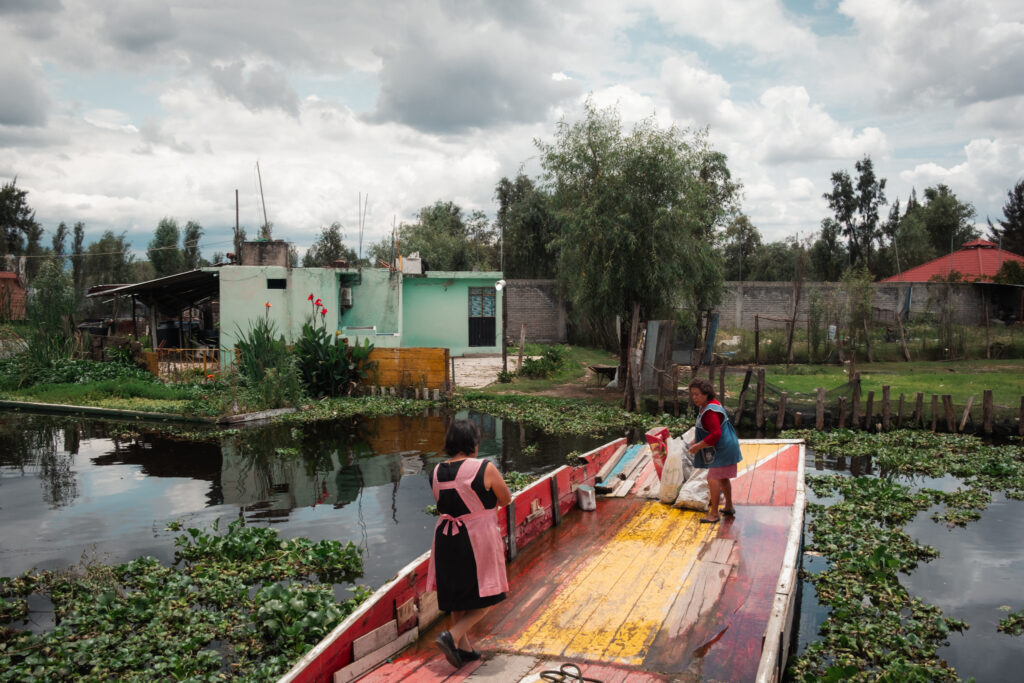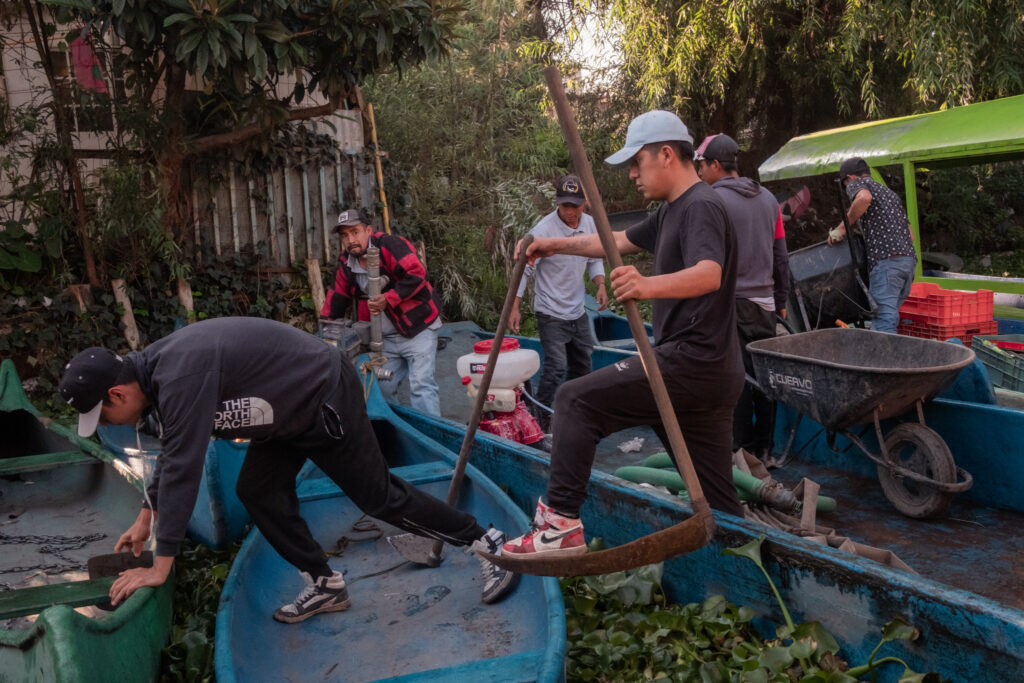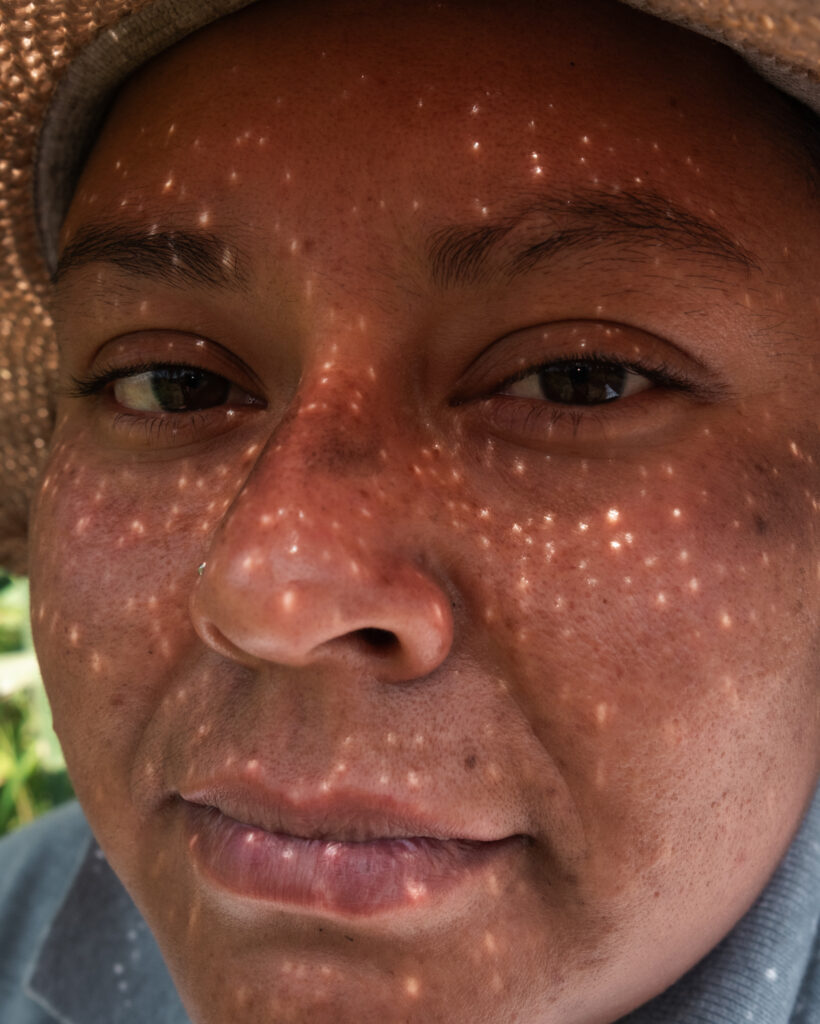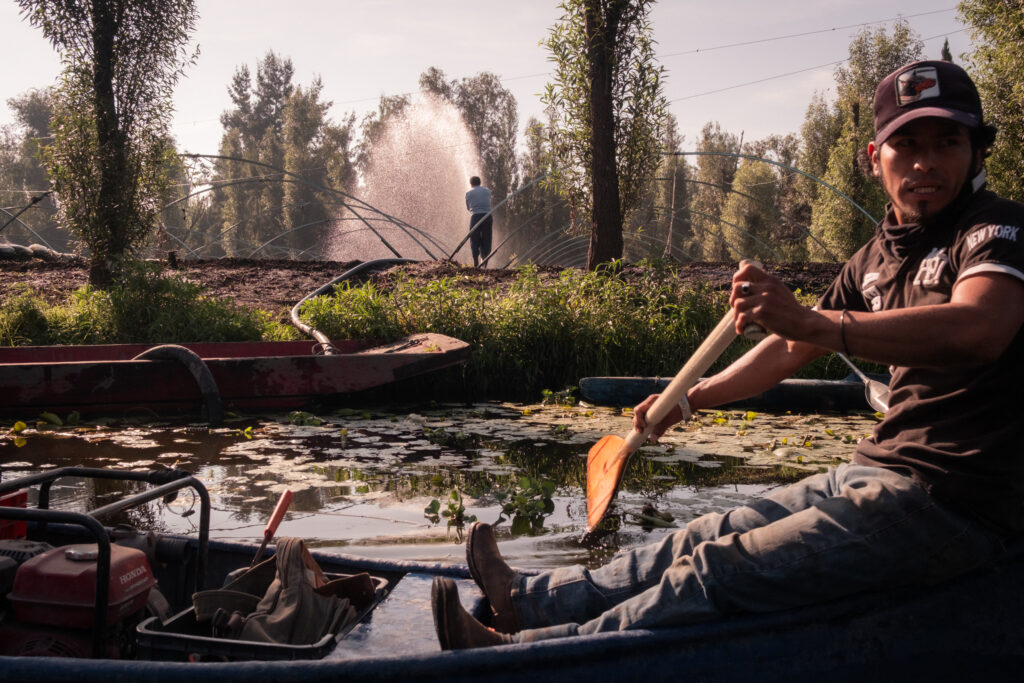More Than Fields: The Spirit of Xochimilco’s Chinampas
The canals of Xochimilco shimmer in the morning light, yet beneath the reflection lies a slow unraveling. Once, these waterways fed an empire. The chinampas — rectangular plots of fertile soil anchored by willow roots — produced maize, beans, and squash in abundance, sustaining the Mexica capital of Tenochtitlan. Today, less than a quarter remain in use and only a fraction, about 2.5 percent, are still actively cultivated. Many have been abandoned or converted into soccer fields and event spaces. Others are clogged with invasive plants as water levels fall. What endures feels fragile, at risk of becoming a display for tourists rather than a living system.

The problem is not only ecological. Generations have drifted from the land. “There is no interest anymore,” says Arturo Plata, a Xochimilco local who grew up farming the chinampas with his father. He remembers when canoes carried vegetables directly to the market in San Gregorio, when canals connected people as much as fields. Now graffiti scars communal markers, water runs shallow, and neighbors mark boundaries with suspicion. “The social fabric is breaking,” he says, pointing to an erosion deeper than soil alone.
Amid these challenges, Arca Tierra, an agroecological collective in Xochimilco, works to restore chinampas through food production, ecological repair, and education. They manage farmland, sell weekly harvests, and run Escuela Campesina — a school of farmers — where young people learn directly from elder chinamperos, the farmers who tend the floating plots.

Efforts to restore the chinampas are often described in technical terms: dredging canals, replenishing soil, improving irrigation. Yet what once sustained them was not technique alone, but a worldview that treated the land as alive. Shrines still dot the waterways. A skeletal temazcal – a traditional Mexican steam bath – leans on a parcel managed by Arca Tierra, recalling ceremonies of healing. Even the birds carry meaning. Egrets, still common along the canals, were once tied to the Mexica homeland of Aztlán. Without the sense of reverence that bound people to soil and water, repair risks being too shallow for material, sustainable impact.
Joy Hernandez, who helps lead Arca Tierra, sees the issue as systemic. “Seventy percent of the chinampas are abandoned,” she explains. “Another twenty percent have been urbanized. Some are even turned into soccer fields because that brings faster money than farming.” She knows that ecological restoration cannot survive without people willing to return to the land. “The average age of farmers in Mexico is over forty-five. Young people do not see it as viable. Many are told by their families: do not do what I did, do not suffer in the fields.”

Climate change deepens the uncertainty. Rains no longer arrive on time, and floods and droughts strike unpredictably. “Farmers are scientists,” Joy says. “They know the winds, the rains, the soil. But now they cannot predict. They just wait and hope for the best.” This unpredictability makes farming more precarious and drives families away from the chinampas.
Still, signs of renewal emerge. At daybreak, workers from Arca Tierra paddle out with tools, pumps, and wheelbarrows. They lie on wooden boards to plant herbs such as cilantro, coriander, and parsley into grids of mud cut from the canal floor. Others guide flat bottom boats and kayaks piled with sacks of fertile soil, restoring plots row by row. “We can produce all year,” Joy explains. “If Xochimilco disappeared, the city could warm by two or three degrees.”

The challenge is not only to restore soil but to restore connection. This is the reason Arca Tierra created the Escuela Campesina. “The idea is that they (the youth) see this as a way of life, not nostalgia. We want them to know it is possible to make a living here, to carry forward ancestral knowledge while adapting to the present,” says Joy Hernández.

For those who remain, the work is more than survival. “Here, you breathe clean air,” says Lina López, holding a beetroot pulled fresh from the soil.

Fernanda Alvarado, 27 years old and a fourth-generation chinampera, describes her bond with the land in even more intimate terms. “I first started working for money, but then I fell in love with them. This chinampa is my favorite,” she says, pointing at the plot that has only recently been restored, where traces of salitre — the salty crust that rises through the soil — still mark the surface. For her, the field is not just a workplace but a refuge. “The chinampa does not let me feel alone. It takes care of me and tells me, forget everything, here you are safe.” She has also learned that the land responds to how one approaches it: “What you give to the earth matters. If you work with joy, if you work happily, then you may have results. But if you work while angry, you might get into an accident.”
Around her, polycultures of greens and fruit trees stretch across the chinampas, their branches laid along paths to hold moisture. A spider web glimmers in the corner of a dry toilet, fragile yet enduring. Arturo Plata, tracing circles in the dirt with his finger, puts it simply: “We are the same earth. Our grandparents said: you are dust, and to dust you will return.”
The work of renewal does not move quickly. It happens in gestures that look ordinary at first: branches spread across soil to hold in moisture, seedlings pressed into squares of mud, medicinal herbs planted alongside flowers. Each act carries more than technique, it carries a way of seeing. “Our strength is in combining ancestral knowledge with regenerative practices,” Joy explains. “It is about learning to live with the environment, not against it.”

The remains of a temazcal lean at the edge of a parcel, recalling a time when purification and healing were woven into daily life. Around it, rows of herbs grow: chamomile, mint, epazote. These are not only crops, but remedies, echoes of rituals that once bound health, soil, and spirit together. Arturo believes this respect is essential. “The land breathes as we breathe,” he says. “When we cut into it carelessly, we cut into ourselves.”

Altars built by those who live and work here still stand among the trees. Some carry candles, others painted birds or stars. They ask for protection, but they also signal something more: that farming is not carried out only with tools, but with reverence. Spirituality here does not arrive as doctrine. It arrives in gestures, in greetings to the earth, in the conviction that survival depends on balance.

Xochimilco is not a relic of the past. It is a living negotiation between abandonment and renewal. The question is not whether the land can still produce — it can, and abundantly — but whether people will remember why it matters. Joy sees hope in Escuela Campesina, where students spend months alongside elder chinamperos. “It is not romantic,” she says. “It is hard work. But some realize it is already part of them. It was in their grandparents, and it returns through their hands.”

The grids of mud speak of this continuity. Each square holds a seed, each seed holds a possibility. When transplanted into the soil, the roots stay intact, the earth travels with them. It is a method both efficient and symbolic: renewal carried forward, soil and all.
The future of Xochimilco will not depend only on pumps or markets. It will depend on whether people can recover the sense that these waters are more than infrastructure. To farm a chinampa is to enter into relationship with something older, larger, and alive. It is to accept reciprocity, to give back as much as is taken, to treat land as kin rather than resource. The shrines, the temazcal, the stories of the egret, all remind us that without a thread to the sacred, even the most fertile soil can turn barren.

The canals keep flowing, carrying both memory and possibility. Women haul mud, men steer kayaks, birds rise into the sky. Along the water’s edge, candles burn in small shrines. The chinampas endure not as relics but as living testaments: survival here requires more than survival. It requires care and reciprocity.
By Noel Rojo